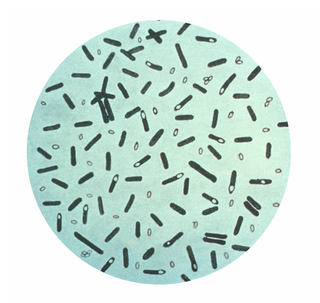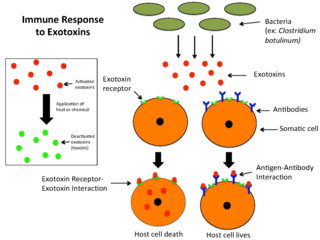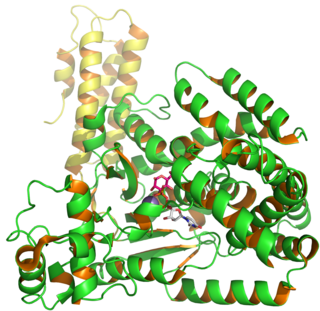Related Research Articles

Botulism is a rare and potentially fatal illness caused by a toxin produced by the bacterium Clostridium botulinum. The disease begins with weakness, blurred vision, feeling tired, and trouble speaking. This may then be followed by weakness of the arms, chest muscles, and legs. Vomiting, swelling of the abdomen, and diarrhea may also occur. The disease does not usually affect consciousness or cause a fever.

Tetanus, also known as lockjaw, is a bacterial infection characterized by muscle spasms. In the most common type, the spasms begin in the jaw and then progress to the rest of the body. Each spasm usually lasts a few minutes and spasms occur frequently for three to four weeks. Spasms may be severe enough to cause bone fractures. Other symptoms of tetanus may include fever, sweating, headache, trouble swallowing, high blood pressure, and a fast heart rate. Onset of symptoms is typically three to twenty-one days following infection. Recovery may take months. About ten percent of cases prove fatal.

Necrotizing fasciitis (NF), commonly known as flesh-eating disease, is an infection that results in the death of parts of the body's soft tissue. It is a severe disease of sudden onset that spreads rapidly. Symptoms include red or purple skin in the affected area, severe pain, fever, and vomiting. The most commonly affected areas are the limbs and perineum.

Clostridium is a genus of Gram-positive bacteria. This genus includes several significant human pathogens, including the causative agents of botulism and tetanus. The genus formerly included an important cause of diarrhea, Clostridioides difficile, which was separated after 16S rRNA analysis. They are obligate anaerobes capable of producing endospores. The normal, reproducing cells of Clostridium, called the vegetative form, are rod-shaped, which gives them their name, from the Greek κλωστήρ or spindle. Clostridium endospores have a distinct bowling pin or bottle shape, distinguishing them from other bacterial endospores, which are usually ovoid in shape. Clostridium species inhabit soils and the intestinal tract of animals, including humans. Clostridium is a normal inhabitant of the healthy lower reproductive tract of females.

Clostridium perfringens is a Gram-positive, rod-shaped, anaerobic, spore-forming pathogenic bacterium of the genus Clostridium. C. perfringens is ever-present in nature and can be found as a normal component of decaying vegetation, marine sediment, the intestinal tract of humans and other vertebrates, insects, and soil. It has the shortest reported generation time of any organism at 6.3 minutes in thioglycolate medium.

An exotoxin is a toxin secreted by bacteria. An exotoxin can cause damage to the host by destroying cells or disrupting normal cellular metabolism. They are highly potent and can cause major damage to the host. Exotoxins may be secreted, or, similar to endotoxins, may be released during lysis of the cell. Gram negative pathogens may secrete outer membrane vesicles containing lipopolysaccharide endotoxin and some virulence proteins in the bounding membrane along with some other toxins as intra-vesicular contents, thus adding a previously unforeseen dimension to the well-known eukaryote process of membrane vesicle trafficking, which is quite active at the host-pathogen interface.

A toxoid is an inactivated toxin whose toxicity has been suppressed either by chemical (formalin) or heat treatment, while other properties, typically immunogenicity, are maintained. Toxins are secreted by bacteria, whereas toxoids are altered form of toxins; toxoids are not secreted by bacteria. Thus, when used during vaccination, an immune response is mounted and immunological memory is formed against the molecular markers of the toxoid without resulting in toxin-induced illness. Such a preparation is also known as an anatoxin. There are toxoids for prevention of diphtheria, tetanus and botulism.
Braxy is an disease which causes sudden death in sheep. It is caused by the bacterium Clostridium septicum.

Gas gangrene is a bacterial infection that produces tissue gas in gangrene. This deadly form of gangrene usually is caused by Clostridium perfringens bacteria. About 1,000 cases of gas gangrene are reported yearly in the United States.

Blackleg, black quarter, quarter evil, or quarter ill is an infectious bacterial disease most commonly caused by Clostridium chauvoei, a Gram-positive bacterial species. It is seen in livestock all over the world, usually affecting cattle, sheep, and goats. It has been seen occasionally in farmed bison and deer. The acute nature of the disease makes successful treatment difficult, and the efficacy of the commonly used vaccine is disputed.
Virulence factors are molecules produced by bacteria, viruses, fungi, and protozoa that add to their effectiveness and enable them to achieve the following:
Clostridial necrotizing enteritis (CNE), is a potentially fatal type of food poisoning caused by a β-toxin of Clostridium perfringens, Type C. It occurs in some developing countries, but was also documented in Germany following World War II, where it was called "Darmbrand". The toxin is normally inactivated by certain proteolytic enzymes and by normal cooking, but when these protections are impeded, and high protein is consumed, the disease emerges.

Clostridium perfringens alpha toxin is a toxin produced by the bacterium Clostridium perfringens and is responsible for gas gangrene and myonecrosis in infected tissues. The toxin also possesses hemolytic activity.

Clostridium tetani is a common soil bacterium and the causative agent of tetanus. When growing in soil, C. tetani is rod-shaped and up to 2.5 μm long. However, when forming spores, C. tetani becomes substantially enlarged at one end, resembling a tennis racket or drumstick. C. tetani spores are extremely hardy and can be found globally in soil or in the gastrointestinal tract of animals. If inoculated into a wound, C. tetani can grow and produce a potent toxin, tetanospasmin, which interferes with motor neurons, causing tetanus. The toxin's action can be prevented with tetanus toxoid vaccines, which are often administered to children worldwide.

Clostridium septicum is a gram positive, spore forming, obligate anaerobic bacterium.

Clostridium difficile toxin B is a toxin produced by the bacteria Clostridium difficile. C. difficile produces two major kinds of toxins that are very potent and lethal; an enterotoxin and a cytotoxin.
Colitis X, equine colitis X or peracute toxemic colitis is a catchall term for various fatal forms of acute or peracute colitis found in horses, but particularly a fulminant colitis where clinical signs include sudden onset of severe diarrhea, abdominal pain, shock, and dehydration. Death is common, with 90% to 100% mortality, usually in less than 24 hours. The causative factor may be Clostridium difficile, but it also may be caused by other intestinal pathogens. Horses under stress appear to be more susceptible to developing colitis X, and like the condition pseudomembranous colitis in humans, an association with prior antibiotic use also exists. Immediate and aggressive treatment can sometimes save the horse, but even in such cases, 75% mortality is considered a best-case scenario.
Clostridium histolyticum is a species of bacteria found in feces and the soil. It is a motile, gram-positive, aerotolerant anaerobe. C. histolyticum is pathogenic in many species, including guinea pigs, mice, and rabbits, and humans. C. histolyticum has been shown to cause gas gangrene, often in association with other bacteria species.
Clostridium chauvoei is an anaerobic, motile, Gram-positive bacterium. In cattle and sheep, a severe infection causes blackleg. Clostridial diseases are considered soil-borne diseases and Clostridium chauvoei, specifically, is known to cause blackleg disease in humans and animals. As it is considered a soil-borne disease, scientists have found a correlation between flooding and the amount of bacteria found in the soil - the spores are redistributed to then contaminate soils, pastures, and water. A study conducted in Taiwan sought to test this correlation by using nucleic acid to extract Clostridium chauvoei from the soil before and after flooding. For the first time, there is evidence to show that the environmental distribution of Clostridium chauvoei is increased after flooding. it is named after Auguste Chauveau who is a French bacteriologist.

Vaccinations for cattle involves the process of applying subcutaneous injections of biological microorganisms in a weakened state to help the immune system develop protection by providing active acquirement of immunity to a particular disease. Cattle are bovine livestock and are thus very susceptible to diseases. Vaccinations for cattle are widely used in the livestock industries of the Australian agriculture sector by farmers to prevent harmful and deadly diseases from infecting their livestock, avoiding any economical or biological harm. Farmed livestock industries account for 45% of the gross value of Australian agricultural output, beef cattle being the largest farmed livestock nationally with around 26.2 million head of cattle nationwide. The beef industry within Australia generates a gross value of approximately $8 billion AUD in beef exports and a total gross value of $11.4 billion in farm production (2017–18). Thus, vaccinations play a vital role in protecting, sustaining and growing the beef cattle industry in the Australian agriculture sector.
References
- 1 2 3 Duncanson, Graham R. (2012). "Vaccines for sheep. Clostridial diseases". Veterinary Treatment of Sheep and Goats. CABI. p. 97. ISBN 9781780640051.
- ↑ Scott, Phillip R. (2006). "Clostridial diseases". Sheep Medicine. CRC Press. p. 125. ISBN 9781840765366.
- ↑ Sargison, Neil (2009). Sheep flock health: a planned approach. John Wiley & Sons. p. 263. ISBN 9781444302608.
| This veterinary medicine –related article is a stub. You can help Wikipedia by expanding it. |